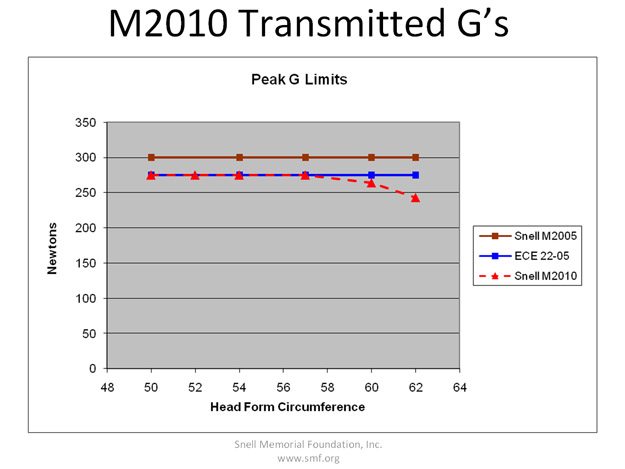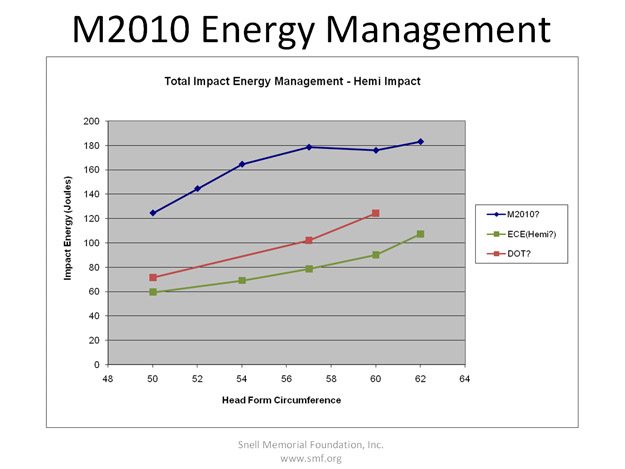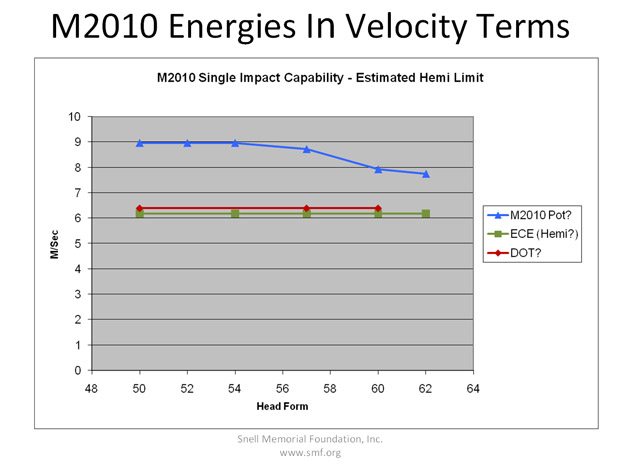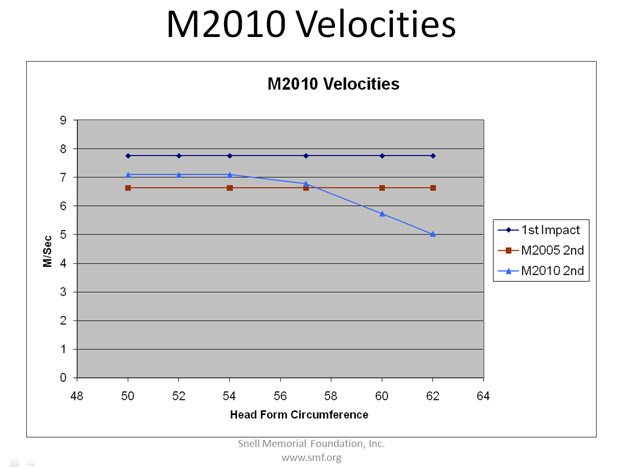Snell M2010 Motorcycle Helmet Standard
Editor’s Note: The final version and information about the Snell 2010 standard was released at a meeting in Newport Beach, California on July 15, 2009.
This is a compilation of the information provided during that event.
The Snell M2010 Standard – Background
Beginning October 1, 2009, the motorcycle riding public will be able to buy and wear motorcycle helmets certified to the new Snell M2010 standard.
There are major differences between M2010 and previous Snell Standards; mostly due to the emergence of ECE 22-05, the standard now in mandatory use throughout the UK and Europe.
Snell motorcycle helmet standards are voluntary; manufacturers build to Snell standards because they want to and they build to DOT, ECE 22-05 or other standards because they have to.
And if it comes to a choice between what a manufacturer wants to do and what it has to do, they will give up Snell for DOT or ECE 22-05 every time.
It’s not like there’s a real choice. In North America, since the mid 1970’s, the mandatory motorcycle helmet safety standard has been the Federal Motor Vehicle Safety Standard (FMVSS) 218, colloquially known as the DOT standard (info).
In the United States, a motorcycle helmet might meet the Snell standard, but it had better meet FMVSS 218. If it doesn’t, the manufacturer, the distributor, the dealer and, depending on the state, the rider would be in for a lot of grief.
For this reason, Snell said that their motorcycle helmet standards have been compatible, at the very least, with the DOT standard.
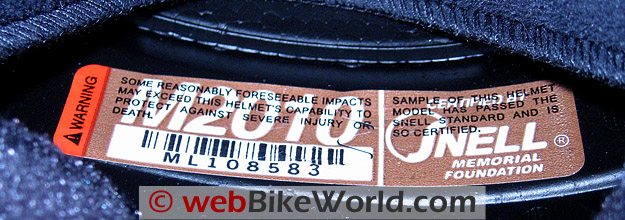
Snell and ECE 22-05
According to Snell, a capable company has always been able to build a helmet which would satisfy both Snell and DOT standards, but not Snell and ECE 22-05. Larger sized helmets with head sizes of 60 cm and up might be able to meet both Snell and ECE 22-05, but this becomes more difficult for smaller sizes, where it is impossible to meet both sets of requirements.
As a result, Snell certified motorcycle helmets are currently allowed for European racing but not for European street riding. Thus, manufacturers who make Snell certified helmets cannot bring their Snell models into Europe. If they want to sell helmets in Europe, they have to build separate, non-Snell helmet versions.
For the same reason, Europeans street riders do not have access to Snell levels of protective performance. Like it or not, they must wear helmets meeting the ECE 22-05 standard, even though the ECE 22-05 standard may, in some regards, offer less protection than even the DOT standard.
Snell M2010 “World Helmet”?
NOTE: For a detailed description, including videos, of the differences between Snell, DOT and ECE helmet safety standards, be sure to read the webBikeWorld article entitled ECE vs. DOT Helmet Safety Standards Explained.
The new Snell M2010 standard resolves this problem. Once it takes effect, manufacturers will be able to build helmets which will satisfy DOT, ECE 22-05 and Snell simultaneously.
The chief virtue of the Snell M2010 standard is that it will enable a “world helmet” which will provide Snell levels of protection to riders in Europe as well as in North America.
For street riders in North America, the differences between M2010 and M2005 should be of little significance. M2010 does not exceed M2005 but it does demand comparable protection. But for street riders in Europe, M2010 may make a considerable difference.
For the first time in years, they may be able to choose helmets which satisfy all the local regulations and provide a premium of protective capability over and above local requirements. Helmets certified to the M2010 standard and ECE 22-05 will provide protection comparable to M2005 and will qualify for sale and use in the UK and Europe.
The new and improved M2010 motorcycle helmet standard is an effort to prevent unnecessary brain and head injury through better headgear, which has been Snell’s mission for over 50 years.
Snell 2010 Safety Standard Description
Following are some of the visuals handed out at the meeting along with a description.
Snell 2010 (and DOT) Advantage
This is a comparison of the impact capabilities of M2010 and DOT versus ECE 22-05. The differences are shown in terms of the percentage improvement DOT and M2010 enjoy over ECE 22-05 in terms of impact velocity management and in terms of impact energy management.
The comparisons are estimations. M2010 and DOT both use double impacts, guided fall devices and the hemispherical impact anvil as opposed to Europe’s single impacts, guided free fall devices and the “kerbstone” impact anvil.
Allowances for the effects of these differences are approximate and are based on testing experience at the Snell laboratory and elsewhere. Snell is confident that the slight advantage estimated for DOT and the substantial improvement estimated for Snell are real and that these estimates are reasonable and justified.
The Snell M2010 Standard – Impact Requirements
The results of that collaboration are shown in this table. There are six head forms, the gap between the 50 cm A head form and the 54 cm E head form is one kilogram. The 52 cm C head form smoothes that out. M2010 is still a two impact standard. A rider cannot change the helmet until the crash is over so the helmet may have to protect for more than one impact.
 Snell M2010 Standard – Transmitted Force
Snell M2010 Standard – Transmitted Force
This is the reason for the lower Peak G criteria for the M and O head forms. The plot shows the transmitted force limits. The brown line is Snell M2005 and the blue line is ECE 22-05.
Snell M2005 allows less force to be transmitted to the largest helmet sizes than ECE 22-05 and possibly even DOT. The red dashed line is Snell M2010; it follows the ECE 22-05 line for the smaller head form sizes but, for 60 cm and greater, the M and O head forms, it breaks to the lower Snell limit. Effectively, the new criterion is the lower of ECE 22-05 or Snell M2005 for each helmet size.
Snell 2010 Standard – Transmitted “G” Force
This graph illustrates one of the most dramatic differences between the Snell M2005 and M2010 standards — the reduced amount of peak G-force allowed to reach the rider’s head.
Snell M2010 allows no more than 275 G for helmet sizes up through 59 cm but, for the two largest head forms, where the ECE 22-05 limit would allow harder helmets than the current Snell M2005, M2010 sets accelerations limits even lower than ECE 22-05.
M2010 sets the peak G-force criteria to 275 G for the medium and smaller helmet sizes. This is level is consistent with every major world standard. The peak G criteria for the two largest head forms are set even lower to assure that the helmets do not transmit any more G’s than previous Snell requirements.
Snell 2010 Standard – Energy Management
These are estimates of the total impact energy management theses standards demand. The M2010 line in blue, DOT in red and ECE 22-05 in green are Snell’s best estimates of the most energy management each standard implies for a single hemi impact.
As you can see, DOT certification implies more energy management than ECE 22-05. Although ECE 22-05 calls out a higher impact velocity, there is only a single impact and the “kerbstone” anvil is much less aggressive than the hemispherical impact called out in DOT. Snell M2010, however, implies substantially more impact energy management than either the DOT or ECE 22-05 standard.
Snell 2010 Standard – Energies in Terms of Velocity
This is the same representation as the previous chart but is expressed in terms of the estimated maximum single impact velocity we might expect from a helmet against a hemispherical anvil.
A European rider with a 22.3 km/h helmet might step up to a 28.0 km/h Snell M2010 helmet. Depending on the rider’s head circumference, the Snell M2010 helmet might even be good for 31.6 km/h. In U.S. terms, this European would go from 13.9 mph protection up to 17.4 mph or even 19.6 mph.
Snell 2010 Standard – Impact Velocities
These are the impact velocities for the Snell M2010 standard. Snell M2010 still requires two impacts at each site on the helmet and the first impact will still be a 7.75 m/sec, the same as in M2005 and just a bit more than the 7.5 m/sec impact in ECE 22-05. But Snell M2010 will then do a second hit at a velocity determined by the size of the test head form.
A through E, sizes up to 56 cm, will be tested at 7.09 m/sec. The J head form, sizes 57 through 59 cm gets a lower second impact but still more than the M2005 velocity. The largest head forms, sizes 60 cm and up, will be tested in progressively lower second impact velocities.
The helmet shell stresses increase dramatically with head form weight so that the helmet industry will likely always be able to achieve better performance for smaller head sizes.
Snell says that “We already know we can’t give riders all the protective performance they might ever need; next best is to give each rider all the protective performance reasonably possible”.
Shell Penetration Issues
Snell and DOT include shell penetration tests with a 3 kg 60 degree conical point dropped from 3 meters. ECE 22-05 does not. Head strikes against foot pegs and other sharp objects are rare but not unheard of, so the shell penetration standard is a plus for motorcyclists.
Snell Testing Facts
Since January 1, 2003: 804 motorcycle helmet configurations certified. 6,090 certification samples tested. 2,514 random sample tests plus 1,098 follow-up tests (3 samples each for 336 series). Manufacturers must also report on production of Snell labeled helmets, along with distribution.
The Snell 2010 Standard – Summary
Remember that motorcycle helmets must also meet local requirements (DOT in U.S.A., ECE 22-05 in Europe and the UK, etc.).
The differences for European motorcyclists is that the Snell 2010 standard requires more impact management than ECE 22-05 and lower G force transmission for sizes 60 cm and up.
Differences for North American motorcyclists include lower G forces transmitted but less impact management than Snell 2005 for sizes 59 cm and less. Snell 2010 still provides more impact management than the DOT standard, however.
For More Information
The Snell Memorial Foundation, Inc., a not-for-profit organization, has been internationally renowned for its dedication to scientific research, standards development, helmet testing, and public education on head injury protection.
Snell currently tests and certifies helmets for auto-racing, motorcycling, bicycling, in-line skating, skiing and equestrian sports. For more information about Snell and Snell certified helmets, please visit the Snell web site (www.smf.org).
Notes on Impact “Dwell Time”
Some questions have been raised regarding a standard for what might be referred to as the “dwell time”, or duration of the impact. Apparently, one of the differences between Snell and DOT helmet safety standards have to do with “dwell time,” or duration of allowed for sustained G’s on the headform.
Apparently, the DOT standard allowed higher peak loads, but required a far shorter dwell time, allowing for less overall force over time. So we asked Snell about the “dwell time” standards for Snell 2010 and received this reply:
“Dwell time has been a contentious issue ever since the 1968 ASA Standard for vehicular helmets introduced the concept back in 1968. The gist of it is that it limits the total length of time the test impact response is allowed to exceed a given value.
The test technician drops the helmet and head form onto the impact surface at the prescribed impact velocity, then the head form begins crushing the helmet’s impact liner and the liner begins pushing back against the head form braking it to a stop. An accelerometer inside the head form measures the deceleration; effectively the amount of “braking” the impact liner is applying to the head form.
DOT calls out a 6 meters per second impact velocity for some tests so the braking takes a little time to accomplish. To an observer, it looks like an eye-blink but the total braking period is likely to be between 5 to 10 milliseconds.
DOT demands that the measured acceleration never exceed 400 g and also that it not exceed 200 g for more than 2 milliseconds, and that it not exceed 150 g for 4 milliseconds.
Snell standards don’t limit dwell times. I’m told that Dr. George Snively, the man who, more than any other, created the Snell Foundation, disagreed with the whole idea of dwell time as a test criterion. The business of helmets is to extend the duration of the acceleration pulse and to limit the peak g values. Putting limits on the duration seemed kind of counterproductive.
The only argument in favor of a dwell time provision is that it could be a limit on rebound. If a helmet has a lot of bounce, an impact event could take twice as long.
The acceleration pulse has to last long enough to slow the head form to a full stop and then, during the bounce, the acceleration pulse lasts even longer to accelerate the head form and helmet up and away from the impact surface.
The fact of the matter though is that most helmets have the same bounce to them. EPS and helmet shell materials have just about the same properties from helmet to helmet so that looking at dwell times does not really get you a less bouncy helmet.
Several investigators have studied peak G and dwell time over the past few years and have concluded that dwell time has little to do with identifying safer head gear. Peak G correlates with identified injury risk factors but dwell time does not.
Even so, all the Snell motorcycle helmets since 1974 have had to comply with the DOT dwell times. M2010 may not mention time duration but all the M2010 helmets sold in the US will still be obliged to meet them to qualify for DOT.
My understanding is dwell times first turned up in the ASA 1968 standard for motorcycle helmets. They looked at it as sort of a hat tip to the Wayne State curve, and maybe the Head Injury Criterion (HIC) which were pretty hot topics in head injury back then.
Researchers at Wayne State had been using blows from a pneumatic hammer to accelerate cadaver heads and looking for skull fractures afterwards. They found that long duration pulses produced skull fractures at lower g’s than short duration pulses.
The Wayne State Curve results were reformulated into the Gadd Severity Index and then into HIC which were complicated mathematical formulas intended to compute the risk of head injury from the time history of the measured head acceleration.
The formulas were too complicated to apply easily to helmet test data back then. They didn’t have the computer gear to acquire and manipulate the accelerometer signals that we do now. So they relied on oscilloscopes and Polaroid cameras for simple pictures of the acceleration pulses. But they could measure peak G and they could measure durations pretty readily.
They also had a different impact test device back then. Instead of guided fall, that is: dropping the helmet and head form onto a rigidly mounted impact surface, they used a swing-away device. The head form was mounted on a horizontal arm and directly under a falling impactor.
When the struck the helmet, the arm, head form and helmet would “swing-away” under the shock of the blow. The ASA 1968 standard allowed both types of device, swing-away and guided fall, and called out equivalent impact test procedures for them.
They increased the velocity of the falling mass in the swing-away test to get the same energy transfer as in the guided fall test so that they would get the same peak G and the same amount of liner crush no matter which device was used.
The only thing they missed was differences in timing. The impact pulse in a swing-away test was only two-thirds to three-quarters of an equivalent guided fall test. When the committee selected the time duration limits for the 1968 ASA standard, they used their experience with swing-away tests as a guide, added a healthy margin to assure that the current helmets would have no trouble with it and wrote it into the standard.
ASA eventually became ANSI and reissued the same standard in 1971 with one change: they no longer allowed the swing-away test device.
Guided fall equipment had replaced most of the swing-away gear in the intervening year so it seemed like the thing to do. Evidently, no one had paid any attention to dwell times during that time but why bother? The procedures for the two different devices were supposed to be equivalent so helmets which had passed on swing-away were expected to pass on guided fall.
Besides, the peak G’s continued to look the same. So it came as a shock when previously successful helmets started to fail the dwell time criteria. They should have been surprised. The guided fall dwell times were necessarily 30% to 50% greater than the swing-away results. So a dwell time limit chosen on the basis of swing-away experience was almost certain to be exceeded in a guided fall test.
Once the ANSI committee found out, they rushed out an addendum to the standard increasing the dwell times by 50% to 3 milliseconds for 200 g and 6 milliseconds for 150 g. It took two years or so but, for a consensus standards organization that’s light speed.
The additional milliseconds solved the problem, or would have except that the Federal Government started work on the DOT standard in the meantime. The government went point for point with the 1971 version of ANSI Z90.1 including the old swing-away dwell times. They refused to adopt the correction ANSI published in 1973 with the extended dwell time allowances. As a result, the DOT standard took a mistake made in 1968 and made it immortal.”
Also on wBW: Motorcycle Safety Page | The ACU Gold Sticker | Extra Large Helmets Page | Motorcycle Helmet Reviews
More: The Snell M2015 Standard | ECE vs. DOT Helmet Safety Standards Explained
Owner Comments and Feedback
See details on submitting comments.


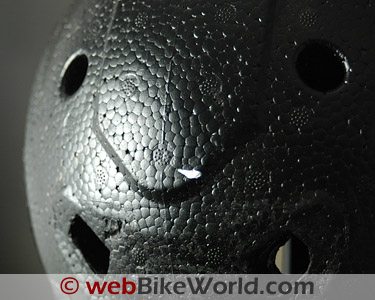
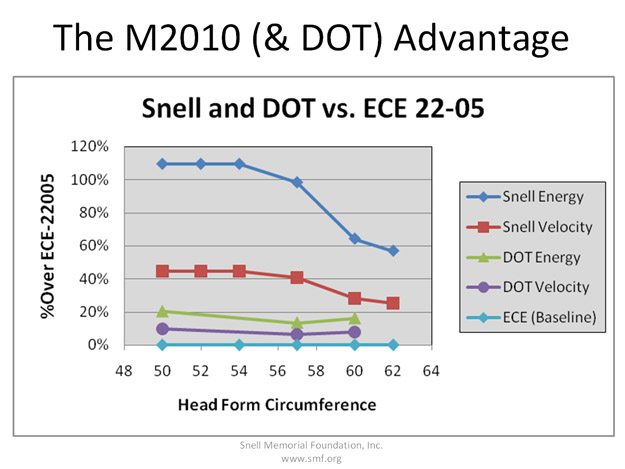
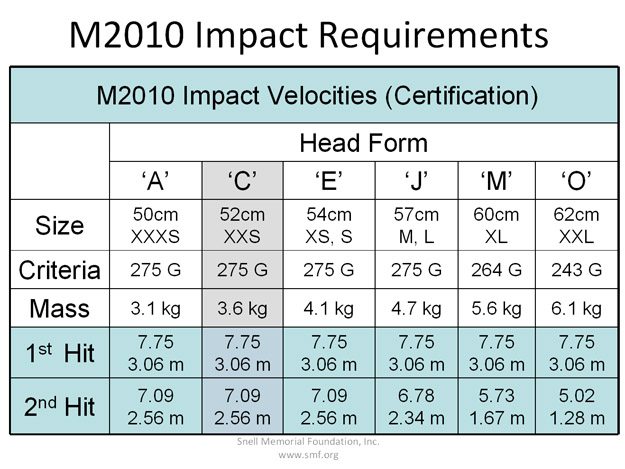
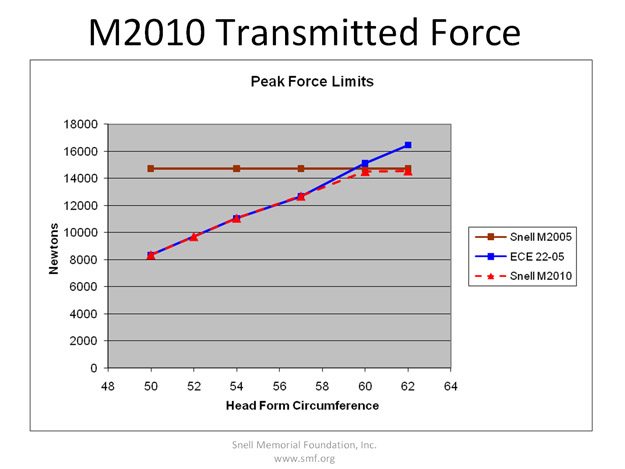 Snell M2010 Standard – Transmitted Force
Snell M2010 Standard – Transmitted Force